
While this drone may remind you of a space ship – maybe something from Star Wars, Star Trek, FireFly or Lost in Space – MMC, the maker of the HyDrone 1800 commercial hydrogen drone, would like you to be thinking about tractors: John Deere, Kuboto, Ford, or International Harvester. Tough, rugged, durable and ready to work.
DRONELIFE recently had the opportunity to view and explore the world’s first commercially available Hydrogen Powered Drone from MMC on a visit to their offices in Shenzhen, China. To test the drone, the team took me from the MMC’s corporate offices in a sleek new building downtown to the warehouse assembly site, about 15 minutes away.

On the top floor of a modest building, MMC’s manufacturing facility is modern and expansive; and it was in this space that the team introduced me to the Hydrone 1800. Up on the roof of the building, the engineering team started up the drone and flew it overlooking the surrounding skyscrapers.
The drone looks like a sports model, with an aerodynamic and sleek design sporting two led lights and six large propellers. It is constructed almost entirely of carbon fiber: the same material used in high end sports cars that need a strong and very light material. The upper part of the unit has a integrated panel that can be removed to show the interior of the drone, and while we can’t publish photos of the interior, one of the things that you notice first is a black, carbon fiber tank of modest size (about the size of a water canteen) which is also carbon fiber,
The drone is manufactured like a sports car, too. Carbon Fiber is created by the use of specialized metal molds, cloth-like sheet of carbon fiber and a sophisticated manufacturing process that combines up to four carbon fiber sheets bonded together in such a way that makes them very light and very strong. A different fiber is used to allow for the use of GPS which the carbon fiber blocks. It is almost unbelievably light, weighing about 2 KG (about 4.5 pounds) or roughly the weight of a full 2 liter soda bottle; extraordinary for it’s width and size.
The hydrogen drone is flown like a small recreational drone with a simple controller, but seemed stable despite the wind and rain on the day that we flew the drone on the roof. (Which we don’t recommend doing here in the US, as you may run into problems with the FAA.) Current flight times are estimated to be between 3-4 hours; an operator will be able to switch the hydrogen canister out and put the drone back in operation in a matter of minutes.
In addition to the longer flight time, the operating temperature of the drone is estimated at – 20 Celsius. Cold weather is an area where where conventional drones using battery power do not do well; so the lower operating temperature expands the field of potential applications for the hydrogen drone.
Despite the Hydrone 1800’s sports car appearance, the creators want to be known as the provider of tractor drones: tough and reliable drones used for commercial applications. The longer flight times and lower operating temps make the Hydrone 1800 a viable option for power line stringing, large scale agriculture, surveying and construction projects.
You can learn more about this drone and the others in the MMC line at mmcuav.com.
CEO DroneLife.com, DroneRacingLife.com, and CMO of Jobfordrones.com. Principle at Spalding Barker Strategies. Has enjoyed working with and around the commercial drone industry for the last 10 years. Attendance and speaker at Industry Events such as Commercial UAV, InterGeo, Interdrone and others. Proud father of two. Enjoys karate, Sherlock Holmes, and interesting things. Subscribe to all things drone at DroneLife here. Email is Harry@dronelife.com. Make Sure that you WhiteList us in your email to make sure you get our Newsletter. Editor1@dronelife.com.